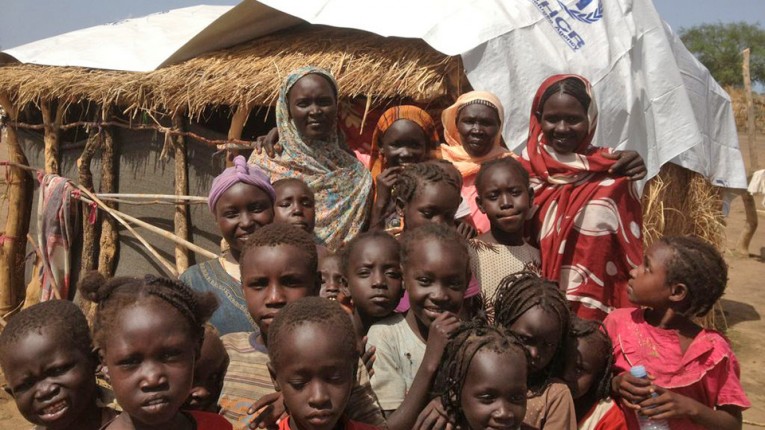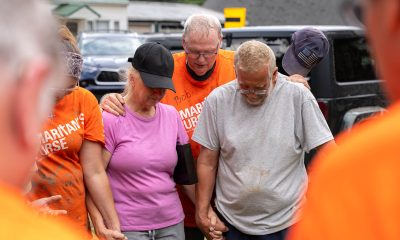Samaritan's Purse staff provide relief supplies while trying to understand the plight of families fleeing violence in Sudan
By Melody Pineda, Samaritan’s Purse communications officer in South Sudan
I arrived in Jamam after an hour’s ride in a white Land Cruiser on a pothole-filled road. Jamam has made the news for the over 30,000 refugees who have fled the violence in Sudan and are calling it home, as well as the severity of the water shortage and poor camp conditions.
Water points are the quickest and easiest ways to meet the local women and children. No matter what time of day it is, there are always dozens of women and children milling around the well, waiting in line. There are roughly eight liters available for each person per day.
“The khawaja woman”—or so I have been called, a fair-skinned American wearing pants and carrying a camera—could not go unnoticed for long. Soon children began coming closer, laughing and staring. The mothers looked over to see what was causing the commotion.
 I began shaking hands with the kids and the numbers grew. Little children pushed among themselves to reach for my hand. I can never say no. To leave one hand outstretched without a handshake seems like a crime.
I began shaking hands with the kids and the numbers grew. Little children pushed among themselves to reach for my hand. I can never say no. To leave one hand outstretched without a handshake seems like a crime.
The little ones crowded around, staring at the camera. After taking their photo, I showed them the result. The children burst into infectious laughter and rapid Arabic. I kept an eye on the camera as it was passed from hand to hand while they all laughed at the photos.
I tried speaking to the mothers as best as I could with the 10 Arabic words I know and sign language.
Pointing to them I said, “Kurmuk?”
Kurmuk is a large town in Blue Nile where most of the refugees live.
 Understanding swept their faces, “Aye, aye! Kurmuk,” they said. Their nodding confirmed to me that it was their home.
Understanding swept their faces, “Aye, aye! Kurmuk,” they said. Their nodding confirmed to me that it was their home.
I responded telling them where I had come from, “America,” I said as I pointed to myself.
“Where is America?” asked one lady, pointing in all directions to demonstrate the question. I was a bit puzzled at first as how to demonstrate that we couldn’t get to America by walking, since that is their method of travel to most places. I held out my hands like an airplane and made a little noise.
They understood as they waved their hands and said, “America!”
We talked some more and the ladies told the story of a refugee through sign language and sounds.
In Blue Nile, there were bombs every day. The children would run away in fear to hide from the explosions. There are bombs when they sleep, and there are bombs when they work.
The ladies made the sound of airplanes and bombs, then demonstrated their fear and how they hide. They had walked to the South Sudan border to escape the violence that threatened their lives, nearly a five-day walk, carrying their children on their backs and surviving on whatever greenery they could find on the trees.
I nodded and pretended to know how they have suffered. But I can’t understand.
 I cannot understand what it is like for my home to be bombed daily for reasons I do not know. I cannot understand what it is like to run starving from my home with only the clothes on my back and children in my hand. I cannot understand what it is like to be removed entirely from my home and my world, and to be thrown into a crowd of tens of thousands at the mercies of governments and humanitarian organizations.
I cannot understand what it is like for my home to be bombed daily for reasons I do not know. I cannot understand what it is like to run starving from my home with only the clothes on my back and children in my hand. I cannot understand what it is like to be removed entirely from my home and my world, and to be thrown into a crowd of tens of thousands at the mercies of governments and humanitarian organizations.
There was a brief pause and we smiled at each other. A woman named Claire then invited me into her home. I accepted, and was soon seated in a plastic chair—the only one—in a little house hardly larger than an American child’s playhouse. It was made of sticks covered partially in grass thatch and plastic sheeting.
A new baby slept with her mother under a mosquito net in a crude bed. The baby was called Mary.
I was suddenly immersed in a world entirely not my own, but the family’s friendliness and generosity absorbed me.
I was offered a glass of water, and faced with the decision to drink it or not. If I did, I was likely to be sick and spending far more time in the latrine than is pleasant. I knew how little water is available to them, and yet they shared what they had with me. I acknowledged their act of kindness in gratitude and drank a little.
They began to ask questions about America. Claire sat down and made the sound of bombs and guns to ask if there is fighting and bombing in America. She was very happy to learn that there is not fighting in America. “Good, good,” she said. “Take my children there.”
I then pointed at their clothing to tell them that it is very beautiful. Women in South Sudan traditionally wear long wraps called thupes, which are twisted up in a way that baffles me. I actually own one, a gift from a friend in Maban. I often found myself getting tangled up in the miles of beautiful fabric.
They asked what the women in America wear. I pointed at my pants and blouse and they laughed. The thought of a country without thupes and pant-wearing women seemed funny.
I left Clair to see the rest of the camp and visit with other families. Nassir, my translator for the rest of the day, took me for a walk about the camp. We met his “sheik,” the leader of the community in that area, and saw a small family sitting together making clay pots for cooking. Nassir said they mix the dirt and clay together then bake the pot in the sun.
 We came across families cooking little bits of their food rations, distributed by Samaritan’s Purse, over charcoal fires on the ground.
We came across families cooking little bits of their food rations, distributed by Samaritan’s Purse, over charcoal fires on the ground.
We saw a little child who was recently discharged from a nutrition center, where he was treated for malnourishment. The journey from Blue Nile to Jamam is so long that most children in that condition die before they reach the camps on the South Sudan side of the border.
There was a tree nearby with many men and boys running up and down it. They were collecting leaves and bringing them down to the ladies waiting below. Someone brought a bunch of leaves to me, motioning that I should eat it.
“Eat it? The leaf?” I thought. They made motions that it tastes good. So, with some significant hesitation, I ate a leaf. I am not quite sure what to compare it to. It didn’t taste bad, but I probably would not ask to eat it again.
 Before going, I asked the ladies to teach me how to wear the thupe, and they were delighted to do so. They showed me how to twist and tie the fabric in a way to make a dress. The children, peeking through the cracks of the hut, laughed at the sight of me wrapped up in Claire’s thupe. I practiced several times and they clapped as I finally mastered the art.
Before going, I asked the ladies to teach me how to wear the thupe, and they were delighted to do so. They showed me how to twist and tie the fabric in a way to make a dress. The children, peeking through the cracks of the hut, laughed at the sight of me wrapped up in Claire’s thupe. I practiced several times and they clapped as I finally mastered the art.
A woman named Raija began to clap and dance with stomping motions common among these woman. “If you go home and the thupe defeats you, come back and we will show you again,” she said.
The time went by too quickly and the evening came. I shook many hands on my way out and thanked everyone profusely. I made no promises of returning, because I knew that I could not.
 One of the women sent me on my way with a handful of cookies she had made that afternoon. It felt nearly sinful to take them because they have so little food. But they insisted. I wanted to cry at their generosity.
One of the women sent me on my way with a handful of cookies she had made that afternoon. It felt nearly sinful to take them because they have so little food. But they insisted. I wanted to cry at their generosity.
The camp is one of three in Maban County, which is host to 103,000 refugees. It would be hard to find Claire and the other families I talked with again among the many displaced and moving peoples.
Claire agreed to walk with me to the point where she picked me up earlier in the day. She insisted on returning me safely to my people.
I watched her as her floral thupe disappeared into the crowd, into a world I will never truly know or understand.






